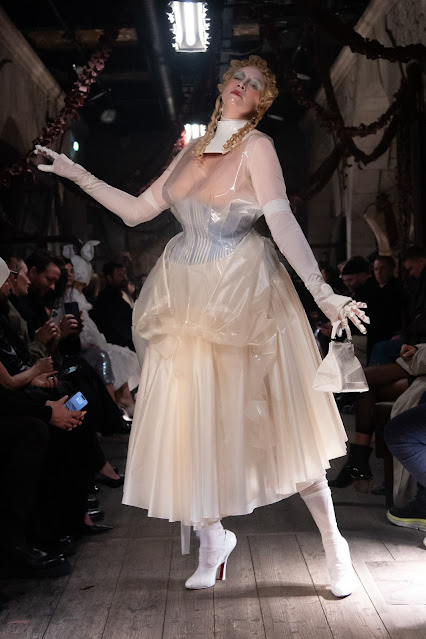“The ritual of dressing is a composition of the self. With the body as our canvas, we build an exterior expressive of the interior:
a form of emotion” ~ Maison Margiela
Video courtesy of: Maison Margiela
Video courtesy of: Vogue
It was one of those rare, unique moments, a moment obliquely reminiscent of those glorious, vintage years in John Galliano's career—the mid 1990s—when, just before landing first at Givenchy and then transferring over to Dior, each (thematic) Galliano show, every season, was something equally to anticipate as well as to behold; confectionary occasions of which dreams and fashion legends are spun: meticulously constructed venue sets worthy of Hollywood at its Golden Age; exquisitely, painstakingly confected articles of hand-crafted clothing; bias-cut, light-as-air gossamer dresses; perfectly styled and maquillaged models; quarried historical details and aesthetics of long-lapsed eras; that sense of theatrical drama and excitement that is so lacking in most collections on display today. It was all there on the drizzly night of January 25th, on the Left Bank of the River Seine.
Reportedly consuming twelve months of preparation and experimental-technical creation and staged in a constructed 1920s “speakeasy”—complete with floor-to-ceiling gilt-framed mercury-backed mirrors, bentwood chairs and violet-flavoured cocktails—under the Pont Alexandre III with some members of the audience seated at café tables outside, under the bridge, while others were seated inside, it was an atmospheric setting—a setting made more so with the first moon of the year contributing its light to the event which included an hour-long anticipatory wait for its beginning. (Adding to the romantic atmosphere of a rainy Parisian night, a soundtrack of rain played on speakers and lightning flashed indoors.) The Maison Margiela Artisanal presentation for Spring/Summer 2024 concluded Couture Week to a resounding success; it can rightly be said that it was the most awaited show of the season. (This happens to also be Galliano's tenth year as creative director, helming Maison Margiela.)
The corset—for both men and women and provided by Maison Cadolle—was the lynchpin around which this collection hinged (literally and figuratively). The corset, too, was the central theme of the short video that preceded the actual presentation. By way of Kryolan Liquid Glass and thanks to the expertise of makeup artist Pat McGrath, porcelain-visaged models—or muses, as Galliano prefers to refer to them—pinch-waisted and padded (the collection expertly melded feminine and masculine, Edwardian and Victorian), meandered through the seated audiences in jerky, puppet-like attitudes and poses. But more than anything, it was the technical innovations and experimentations that thrilled. As Alexander Fury enthused in AnOther Magazine, “Summarising the different approaches and inventions and experimentations in this collection would take forever, but suffice to say they managed to meld old-school and high-tech, in an extraordinary expansion of what couture can mean. There were silicone treatments to make fabrics seem soaked, dragged through water or rained on; tweeds were treated with glue and crepe then boiled to shrink and mould the material. Coats were made from layers of organzas and chiffons printed to resemble heavy-duty wools, then smothered in tulle. Lace dresses were decoupaged, to appear apparently seamless. In short, nothing was as it appeared—including 'porcelain' neck-pieces, actually made from polished leather. It was an astonishing, extraordinary, you-need-to-be-there-to-believe-it moment in fashion trickery.”
Corsets and “porcelain” neck-pieces notwithstanding, silk tulle was used throughout the forty-four-piece collection. Other traditional materials used were such couture staples as silk organza, felt, crin (a synthetic netting made from polypropylene), velvet, boiled tweed, satin, georgette, and chiffon. But there were other, in-house fabrics and techniques, newly developed by Galliano and his team in the Margiela ateliers; these included seamlace—garments constructed entirely from encrusted fragments of lace or other material decoupaged together, resulting in a completely seamless form like one big meandering embroidery—milletrage—a new technique denoting featherlight garments posing as heavy-duty coats, jackets or trousers. Created from layers of fine lightweight fabrics, they are finished with a fabric printed in the trompe l'oeil of a classic menswear textile such as tweed, herringbone or coarse wool .... they are aquarelled (aquarelling is a new term used for the draping of tulle or muslin in the same way a painter works with watercolours) with a violette of tulle printed to appear moon-faded, sun-bleached, tobacco-stained or oily as illumed by the reflection of water at night—and retrograding—a new technique that embodies variations of thread-work, applique or encrustation - such as petals, godets, rosettes and ruching - which degrade from the bottom to the top of the garment. (Source: Maison Margiela)
Fashion invariably mirrors its time; authentic fashion—fashion that is invested with genuine design merit—has relevance: long-lasting, steadfast relevance and resonance, that endure beyond its time of creation and therefore deeming it timeless. The seasoned wizardry of John Galliano still enthralls and still proves to be beguiling; through interminable years of technical experimentation and mastery of craft, he is still able to push the boundaries of creativity within the métier of dressmaking. In the hands of a master couturier such as Galliano, haute couture still has relevance, can still resonate, even in a world currently on fire, a world in need of escapism.
Sources: Socha, M., Maison Margiela Artisanal Couture Spring 2024, WWD, January 26, 2024; Fury, A., Why John Galliano's Astonishing Margiela Show Will Change Fashion Forever, AnOther Magaizne, January 26, 2024; Zetlaoui, L.,What makes the Maison Margiela Artisanal show Spectacular?, Numero, February 6, 2024.
The above forty-four images are courtesy of: Dazed












































No comments:
Post a Comment